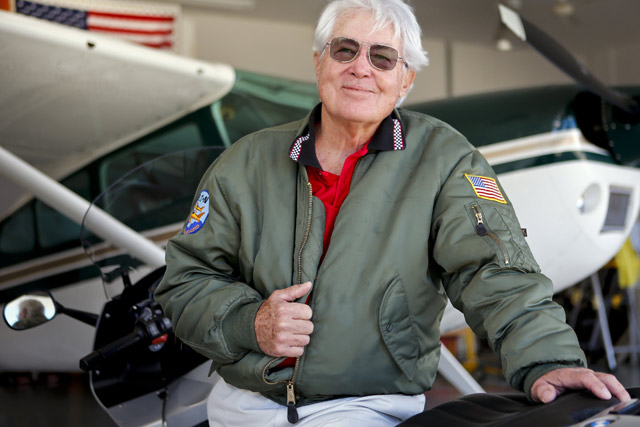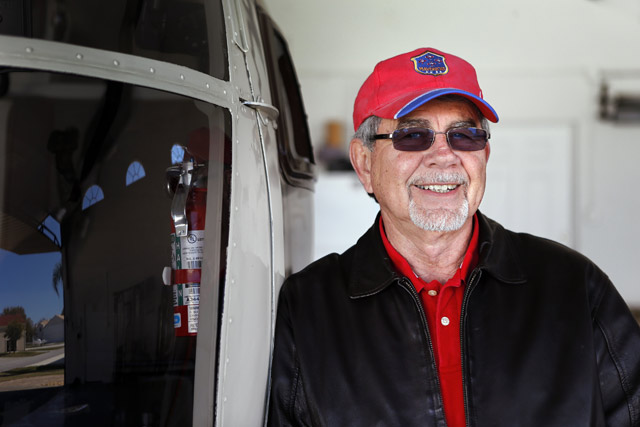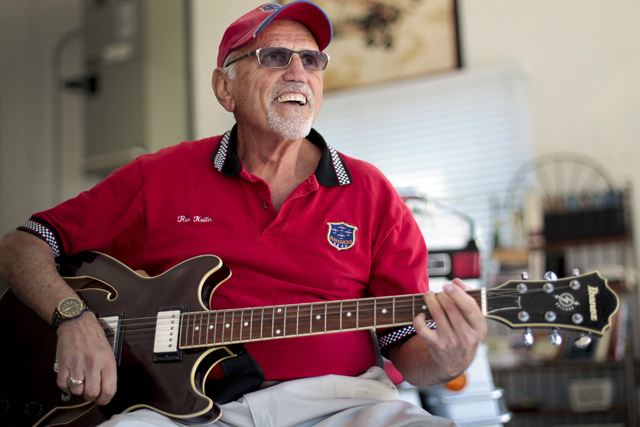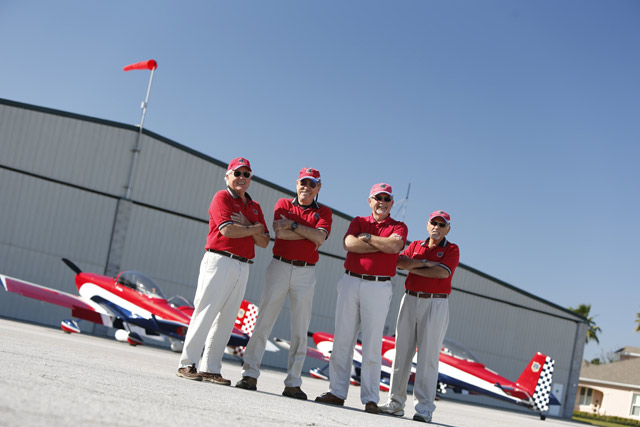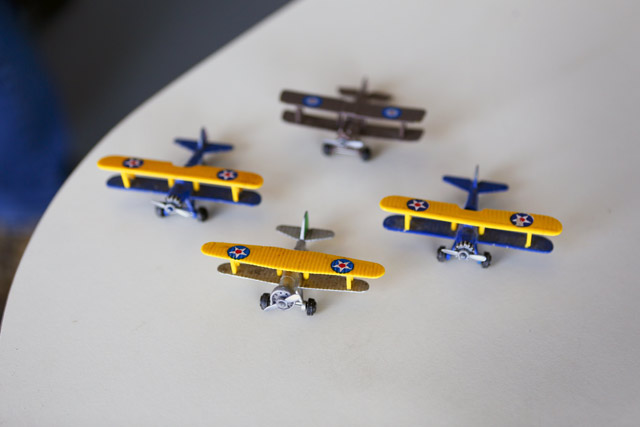Overlapping wings bring their four airplanes so close that even tiny relative movements seem gigantic. It’s a golden Florida evening, and unlike other retirees, the Mavericks—a group of mostly seventy-something former airshow performers—are in the midst of a strenuous formation aerobatic flight. Each close-quarters maneuver requires precision, finesse, confidence, and physical strength from every pilot.
“Wings level, powering up,” team leader Bob Gandt calls on the radio as the four aircraft (Gandt’s Van's RV–7 and three RV–8s) begin diving from 3,000 feet in a diamond formation. As they reach 190 KIAS, Gandt, in a soothing, measured cadence, calls: “Here we go, up!”
Gandt, 75, smoothly pulls on the stick and within seconds all four pilots are subjected to four times the normal force of gravity as their red, white, and blue airplanes arc upward into the twilight. Near the apex of the maneuver, Gandt clicks his mic to let the others know he’s “coming back on the power,” allowing the other pilots to make throttle adjustments and descend as one.
Constant-speed propellers growl as the four airplanes dive vertically, just feet apart.
“Gs coming on,” Gandt says, applying firm back pressure as the pilots emerge from their dive in unison at precisely the same altitude at which they began.
Unlike other formation aerobatic teams that seek corporate sponsorships, large performance venues, and media coverage, the Mavericks do this demanding, hazardous, and unforgiving flying purely for their own private reasons: Shared goals, long-term friendships, personal challenges, and satisfaction. There are no crowds, paydays, or accolades except for the hard-won compliments they sometimes give each other.
“We don’t fly like this because it’s easy; we do it because it’s hard,” says Gandt, a former U.S. Navy and Pan Am/Delta Air Lines pilot, and author. “Just like artists or musicians, we’re constantly striving to master our craft, to try new things, to improve. That’s the mission we share. And as we age, having a mission becomes more important than ever.”
Even in Florida, where Ponce de Leon searched in vain for a fountain of youth, the Mavericks know there’s no such thing. Their faces are weathered, and they wear reading glasses or hearing aids. The Mavericks volunteer for “missing man” flyover tributes for fallen friends—a frequent and poignant reminder that life, even for flyboys, is fleeting.
Although the Mavericks have flown together for years, and rehearsed many of the same maneuvers countless times, they say it still feels fresh. Recently, they’ve been practicing a new series of line-abreast maneuvers, adding them to their already deep repertoire.
Just as concert pianists find new interpretations for well-known music, the pilots find new levels of understanding in the maneuvers they perform.
“I still get a rush of adrenaline whenever we fly,” says Ron Keilin, 78, a retired dentist who has flown aerobatics at airshows individually and as part of formation teams for 35 years. “No two flights are exactly the same. And what you did on your last flight doesn’t mean anything for the next one. There are always ways to improve and more to learn. We pursue perfection, but no one ever quite attains it.”
The Mavericks fly together at least once a week, usually on Saturday mornings, and always at Spruce Creek—the Central Florida fly-in community where all four reside. On the ground, their banter mostly consists of merciless teasing—about themselves, or anyone else who happens to come within earshot.
“Is this interview for the AOPA or the AARP?” Jim Weldon, 78, asks mischievously.
“Suck in your gut,” Gandt tells fellow Maverick Jim Calhoun during a group photo shoot.
“I will, but you’ve got to give me a countdown,” Calhoun tells AOPA Photographer Chris Rose. “If I suck it in too long, I’m liable to pass out.”
“We’re putting our faith in Photoshop,” Keilin chimes in.
“No scratching!” Gandt barks to no one in particular.
The Mavericks wear identical red shirts, baseball caps, and khaki pants, but a passerby points out their mismatched footwear.
“We need a shoe sponsor,” Weldon says.
“No, we’re not asking for any sponsorships,” Gandt answers. “Not after Metamucil turned us down.”
Rose asks Calhoun, 69, whether he’s the youngest Maverick.
“I am,” the retired Delta pilot says with feigned indignation. “And I’m deeply offended you had to ask.”
Together, the Mavericks count more than 220 years of flying experience between them. Each learned to fly as a teen, and three made it their profession. But the large number means little to Gandt.
“Don’t be impressed by total flight hours,” he says dismissively. “Some of the worst pilots I ever flew with were senior airline captains with tens of thousands of hours of flight time.”
A corporate jet noisily streaks overhead, and Gandt looks up.
“There, but for the grace of God, don’t go I,” he says.
“Been there, done that,” Weldon agrees.
Italian mistress
It’s easy to see similarities in the Maverick bios, but these pilots aren’t shaped by the same cookie cutter. They’re from different regions of the country, and they come from various aviation tribes. Gandt flew Navy fighters and later joined Pan Am/Delta; Weldon flew both Air Force bombers (B–47s) and fighters (F–86s and F–84s), and spent several years flying medical missionaries in Mexico; Calhoun was an Army helicopter pilot before joining the “original” Delta; Keilin was a civilian flight instructor before, during, and after dental school.
Their interests outside formation flying also vary. Gandt is an accomplished author of 14 books, a screenwriter, and recently returned from an adventure trip to Antarctica; Weldon owns and flies a Cessna 180 on rugged backcountry explorations; Calhoun serves on the resident board that manages the Spruce Creek airport and community; and Keilin is a skilled aircraft builder.
In fact, Keilin helped shift the Mavericks from their former airplanes—Italian-built SIAI-Marchetti SF.260s to the Experimental-category RVs.
“I owned a Marchetti and built an RV–8 and wanted to see which one I liked more,” he said. “The RV is light and responsive. We’re all living on fixed incomes, so the fact that it’s got four cylinders instead of six and you can work on it yourself makes it a whole lot more affordable.”
When Keilin sold his Marchetti, the others eventually followed, although Gandt did so grudgingly and confesses that he still misses the sleek, stylish two-seater.
“The Marchetti was like an Italian mistress,” he says. “High maintenance and expensive, sure. But wonderfully exciting, too.”
Gandt says the Marchetti, with its higher wing loading, also flies better in turbulence. But Keilin has a pat answer for that.
“Since we’re not doing airshows anymore, who cares?” he says. “If it’s bumpy, we don’t have to fly.”
Brutal honesty
Every Mavericks flight begins with a detailed briefing, even though few aspects change from one practice session to the next. The pilots almost always fly the same positions (Gandt leads, Keilin is left wing, Weldon is right wing, and Calhoun is slot) in the same airspace. The only change from their airshow performances is altitude: They typically maneuver at about 2,000 feet agl now instead of 200 feet at airshows.
“We start with a very clear plan,” Gandt said. “We stick to the plan, and we don’t make changes or argue in the air. If our plan isn’t working the way we’d like, we’ll make a new plan and try it on our next flight.”
Each flight is followed by a debriefing in which all team members candidly share their thoughts and observations.
“The key is a free flow of information and being willing to tell it like it is,” Calhoun says. “It’s not always easy to hear, but it’s essential.”
Group members disagree about whether they have disagreements, though.When Weldon says he can’t remember ever getting crossways with his fellow pilots, Gandt rolls his eyes.
“It’s not that he doesn’t remember,” the lead pilot says. “It’s just that he doesn’t hear very well.”
Gandt says the tiki bar inside his hangar is the perfect spot to bring up conflicts, and resolve them.
“We get pissed off at each other,” he said. “Then we have a drink, talk about what’s bothering us, have a laugh, and pretty soon we’re not pissed off anymore. The process isn’t that complicated.”
The only question the Mavericks don’t seem to have a quick answer for is how long they will keep flying together and what might cause them to stop.
Calhoun says he’ll take his cues from the more senior pilots on the team.
“These guys are about 10 years older than me and they’re still going strong,” he says. “That gives me a reasonable expectation that I can do this another decade or so at the very least.”
But Calhoun, a Vietnam veteran, takes nothing for granted.
“I’ve regarded every day of the past 47 years as a bonus,” he said. “We’ve all been around enough to know there are no guarantees in life. I’m truly grateful for every moment I get to fly with these guys.”
Email [email protected]
Photography by Chris Rose
Video: Fly along with the Mavericks in this online video.


